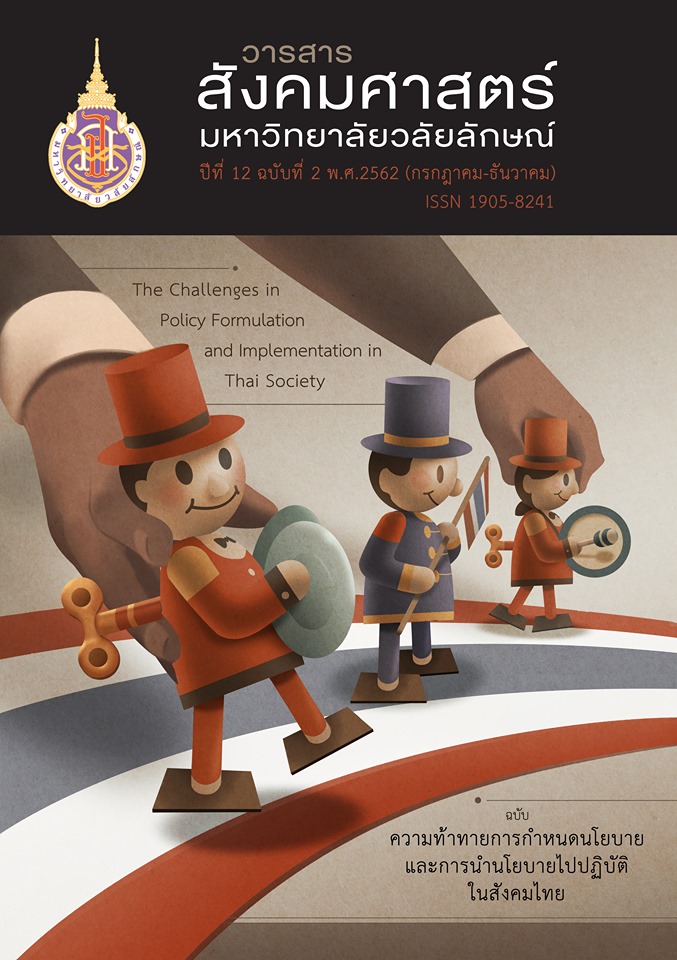Professional Development of Chinese Teachers in Thailand based on Hanban's Standard Framework for Teacher of Chinese to Speakers of other Languages
Main Article Content
Abstract
The Professional Development of Chinese Teachers is a national urgent mission for the demand of Chinese language has been rising in the labor market of the 21st century. With the ever-changing society, teachers of Chinese must constantly improve themselves in order to keep up with Thai and global social climates.
This article presents Hanban’s Standard Framework for Teacher of Chinese to Speakers of Other Languages to be adopted by Thai Chinese teachers. The framework content is categorized in 7 concrete elements, which are: 1) elementary knowledge and 5 skills of the Chinese language, 2) modern Chinese teaching methods for the 21st century, 3) creative and innovative Chinese education, 4) cross-cultural communication, 5) self-development in teaching profession, 6) educational researcher, and 7) the spirit of being a teacher. All in all, this article strives for the students’ success in their education, life and careers, not without creative and ethical minds. It is firmly believed that a life-long Chinese language skill can further develop Thai community, society and nation in the future.
Article Details
Copyright: CC BY-NC-ND 4.0
References
HANBAN国家汉办. (2015). Guoji Hanyu Jiaoshi Biaozhun (2012ban): [Standards for Teachers of Chinese to Speakers of Other Languages (2012edition)]. Retrieved from https://wenku.baidu.com/view/f374b746a58da0116c1749f2.html
Hellboy2007. (2012). kānwičhai nai chan rīan [Classroom research]. Retrieved from https://etraining2012.wordpress.com
Hudongbaike. (2015). kuawenhuajiaoji[cross-cultural communication]. Retrieved from http://www.baike.com/wiki
Kidānan malithǭng. (1997). theknōlōyī kānsưksā læ nawattakam [Educational technology and innovation]. Bangkok,Thailand: Chulalongkorn University.
Kumaravadivelu, B. (2001). Toward a Postmethod Pedagogy. TESOL Quarterly, 35(4), 537-557.
Ladawan kǣo Sinourn. (2008). kānsư̄sān rawāng watthanatham : tāng sumnīang tǣ sīang dīaokan [Intercultural communication: different accents the same sound]. Retrieved from file:///C:/Users/USER/AppData/Local/Microsoft/Windows/INetCache/IE/STNC538G
Likhit Dhiravekin. (2006). botbāt khō̜ng prathēt Čhīn læ phāsā Čhīn nai satawat mai [The role of China and Chinese in the new century]. Retrieved from https://mgronline.com/daily/detail/9490000074640
Liu Xun. (2002). Hanyu Zuo Wei Di Er Yuyan Jiaoxue Jianlun [A Brief Discussion on Chinese as a Second Language Teaching]. Beijing, China: Beijing Language and Culture University Press.
Mayurī dūang sī. (2015). khrū mư̄ʻāchīp yuk ʻĀsīan[Professional Teacher to ASEAN]. Journal of Periscope Education,Year 2(1), 32-42.
Ministry of Education. (1999). khamʻathibāi phrarātchabanyat kānsưksā hǣng chāt [Description of the National Education Act]. Retrieved from http://www.moe.go.th/hp-vichai/ex-prb05-4.htm
Phra Maha Wutthichai Wachirametee. (2010). čhit winyān khwāmpen khrū [Spirituality of Teachers]. Retrieved from https://www.youtube.com/watch?v=YCc_oZy9Izs
Rātchabanthittayasathān. (2003). photčhanānukrom chabap rātchabanthittayasathān Phō̜.Sō̜. 1999[Royal Academy Dictionary 1999]. Bangkok,Thailand: Nanmee Book Publishing.
Rātchakitčhānubēksā. (2013). khō̜bangkhap khuru saphā wādūai čhanyāban khō̜ng wichāchīp Phō̜.Sō̜. 2013 [Teachers Council Rules On professional ethics 2013]. Book 130, Special Episode 130.
Rātchakitčhānubēksā. (2013). khō̜bangkhap khuru saphā wādūai māttrathān wichāchīp Phō̜.Sō̜. 2013 [Teachers Council Rules On professional standards 2013]. Book 130, Special Episode 130.
Rātchakitčhānubēksā. (2017). khō̜bangkhap sathāban khunnawuthi wichāchīp ( ʻongkān mahāchon ) [Professional Qualifications Institute Regulations (Public Organization)]. Volume 134 Special Episode 104.
Sinthaphānon, S. (2010). nawattakam kān rīan kānsǭn phư̄a phatthanā khunnaphāp khō̜ng yaowachon. (Phim khrang thī sī) [Innovative teaching and learning to improve the quality of youth. (4th edition)]. Bangkok, Thailand: 9119 Printing Techniques.
sūn Čhīn sưksā sathāban ʻĒchīa sưksā Čhulālongkǭnmahāwitthayālai. (2008). khwāmrūammư̄ Thai - Čhīn dān kān rīan kānsǭn phāsā Čhīn nai prathēt Thai [Thai-Chinese Cooperation in Chinese Language Teaching in Thailand]. Bangkok, Thailand: LP Sriboon Computer - Printing.
Thai Encyclopedia and Dictionary Project for the Youth. (1999). Kānsưksā [Education]. Retrieved from http://kanchanapisek.or.th/kp6/sub/book/book.php?book=12&chap= 2&page=t12-2-infodetail04.html
Thanēt Suphong. (2015). khwāmmāi khwāmsamkhan ʻongprakǭp læ praphēt khō̜ng nawattakam kānsưksā [Meaning, importance, composition and type of educational innovation]. Retrieved from https://thanetsupong.wordpress.com
The Office of Chinese Language Council International. (2007). Guoji Hanyu Jiaoshi Biaozhun [Standards for Teachers of Chinese to Speakers of Other Languages]. Beijing,China: Foreign Language Teaching and Research Press.
Wīraphong rāmāngkūn. (2017). Čhīn nai wēthī kānmư̄ang lōk [China in the World Politics Review]. Retrieved from https:www.prachachat.net/opinion-column/news-21643


